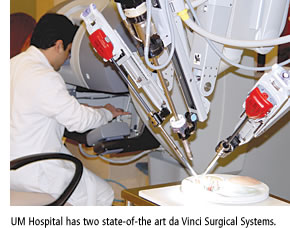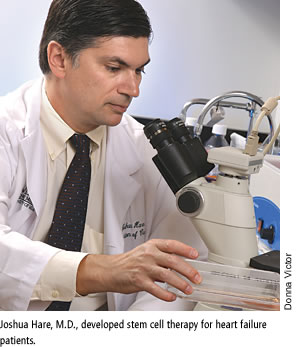Hospitals associated with university health systems are generally among the first to use breakthrough therapies and offer the latest technology. University of Miami Hospital, the cornerstone of UHealth, will be no exception when it comes to the newest treatments and innovations.
Robotics: Surgery in High Definition
 The hospital has two state-of-the-art da Vinci Surgical Systems, including the latest model that reveals the surgical field in high definition. Using the robotic system, the surgeon operates while seated in a console viewing three-dimensional images of the surgical field. Robotic-assisted surgery is similar to other minimally invasive surgery in that the camera and any other necessary instruments are inserted through very small incisions. The hospital has two state-of-the-art da Vinci Surgical Systems, including the latest model that reveals the surgical field in high definition. Using the robotic system, the surgeon operates while seated in a console viewing three-dimensional images of the surgical field. Robotic-assisted surgery is similar to other minimally invasive surgery in that the camera and any other necessary instruments are inserted through very small incisions.
Miller School Dean Pascal J. Goldschmidt, M.D., is a strong supporter of robotic surgery for specific applications—in fact, he brought the very first da Vinci commercial prototype to the United States when he was the director of Ohio State University’s Heart and Lung Institute and head of cardiology.
“We are creating a center of minimally invasive and robotic surgery at UM Hospital, and as someone who first recognized this technology as groundbreaking, you can be sure our expertise will be superior with many surgical options for our patients,” says Goldschmidt.
“The big advantage to robotic minimally invasive surgery over traditional laparoscopic procedures is that the extensive instrumentation allows surgeons to perform maneuvers that cannot be done by the human hand,” says Raymond Leveillee, M.D., professor of clinical urology and radiology and chief of the Division of Endourology, Laparoscopy and Minimally Invasive Surgery at the Miller School.
“Currently, urologic procedures account for 80 percent of the market for robotic-assisted surgery, and many of those procedures are for prostate cancer.”
The robotic-assisted surgery program at UM Hospital is also being used extensively in gynecologic oncology for such procedures as radical hysterectomies, staging for endometrial cancer, and some ovarian cancer.
“Because of the high-definition camera, the field of vision is so incredible you feel much more confident using the robot,” explains Matt Pearson, M.D., assistant professor of clinical obstetrics and gynecology and director of gynecologic oncology robotics. “Especially in cancer surgery, you can get up real close with the camera and identify blood vessels you wouldn’t normally be able to see, and that is truly an advantage.”
Plans are also in the works to develop a minimally invasive robotics program for benign gynecological surgeries. “We plan to offer such procedures as hysterectomies, myomectomies or fibroid removals, and ovarian cystectomies,” says Nahida Chakhtoura, M.D., chief of obstetrics and gynecology at UM Hospital. “Right now the national average for hysterectomy to be done through minimally invasive surgery is just over 30 percent. We hope to build our program to about 80 percent within two years.”
Innovative Cardiovascular Therapies
from Brilliant Minds
 A minimally invasive cardiac surgery program is also in the works and will be just one of several powerful service lines offered by the Cardiovascular Division. A minimally invasive cardiac surgery program is also in the works and will be just one of several powerful service lines offered by the Cardiovascular Division.
The promise of stem cells to treat heart attack and heart failure patients is being offered at all the hospitals in University of Miami Health System. Patients with heart failure, who are scheduled to undergo cardiac surgery, are currently being recruited to take part in a clinical trial using stem cells. The patients would receive the stem cells during their surgery.
“The implications for this kind of therapy are enormous when you consider nearly five million Americans suffer from heart failure, and 500,000 new cases are diagnosed each year,” says Joshua Hare, M.D., chief of the Cardiovascular Division and director of the Interdisciplinary Stem Cell Institute at the Miller School of Medicine. Heart failure, or congestive heart failure, can be a life-threatening condition in which the heart can no longer pump enough blood to the rest of the body.
The health system is also expanding its already distinguished electrophysiology program. Vivek Y. Reddy, M.D., the new director of the electrophysiology section, was previously director of experimental electrophysiology at Massachusetts General Hospital, a teaching affiliate of Harvard Medical School.
“We are going to build a world-class cardiovascular center specializing in heart rhythm disorders,” says Reddy. “We have already hired three new members of our team, and they will join the renowned electrophysiologists already on the faculty.”
The center will focus on the use of catheter ablation to treat complex cardiac arrhythmias, including arterial fibrillation and ventricular tachycardia, as well as resynchronization therapies to treat congestive heart failure.
UM Hospital will also be the first site in Florida to conduct a clinical trial of a new heart valve that can be implanted without open-heart surgery. The Edwards SAPIEN transcatheter heart valve was developed for patients with severe aortic stenosis who are high risk or not candidates for conventional open-heart valve surgery.
“In most cases, narrowing of the aortic valve is a function of aging, and with people living longer we will see more of this problem,” says Alan Heldman, M.D., clinical chief of the Cardiovascular Division. “As we age, though, the risk of undergoing open-heart surgery also increases, which is why it is imperative that we find a new and less invasive way of repairing the aorta.” |


